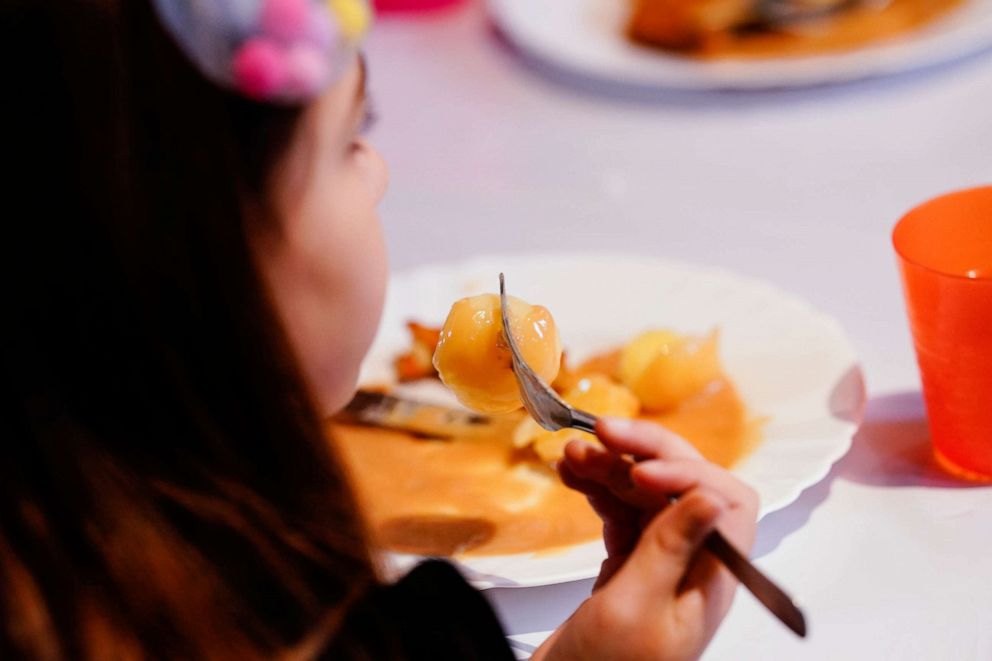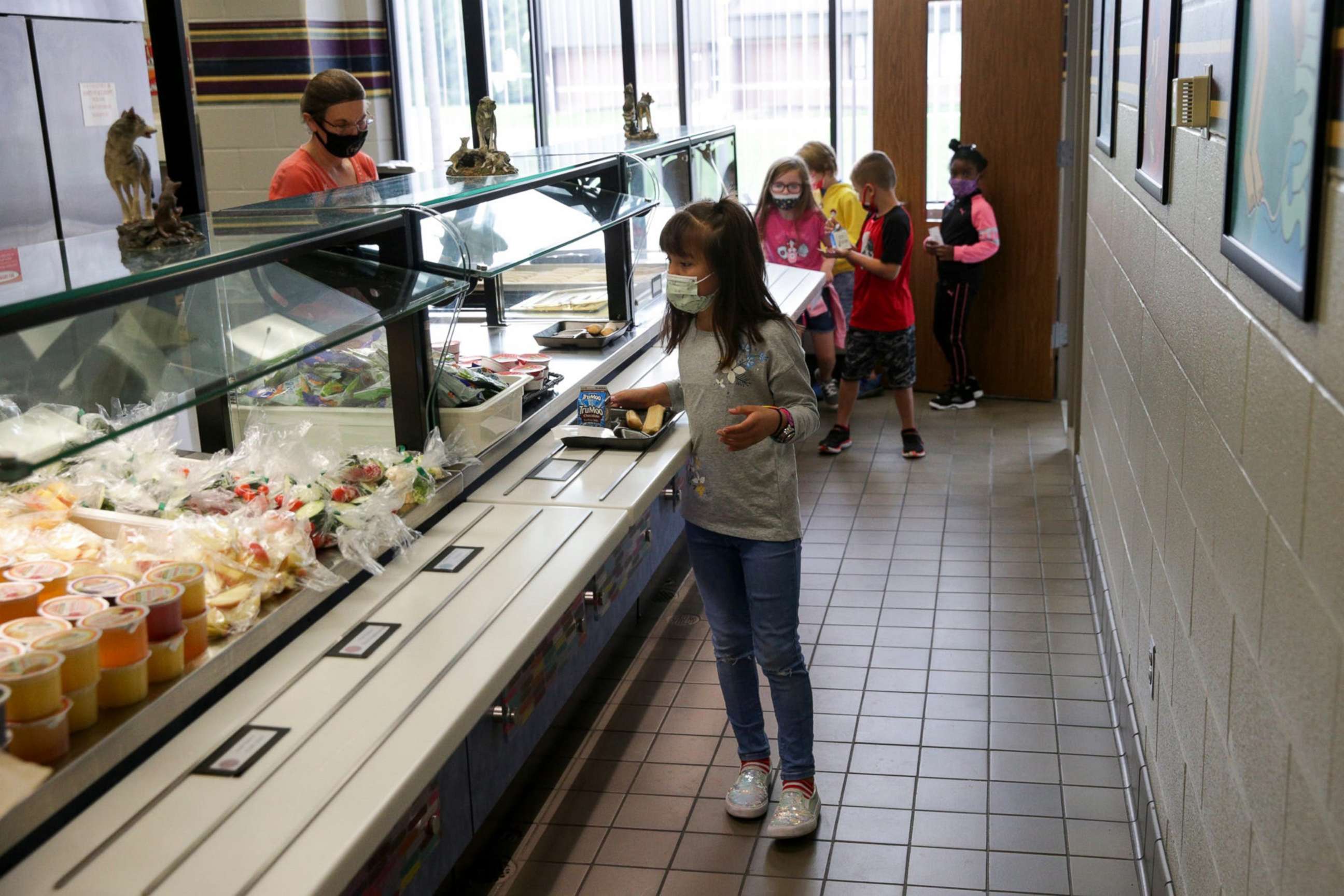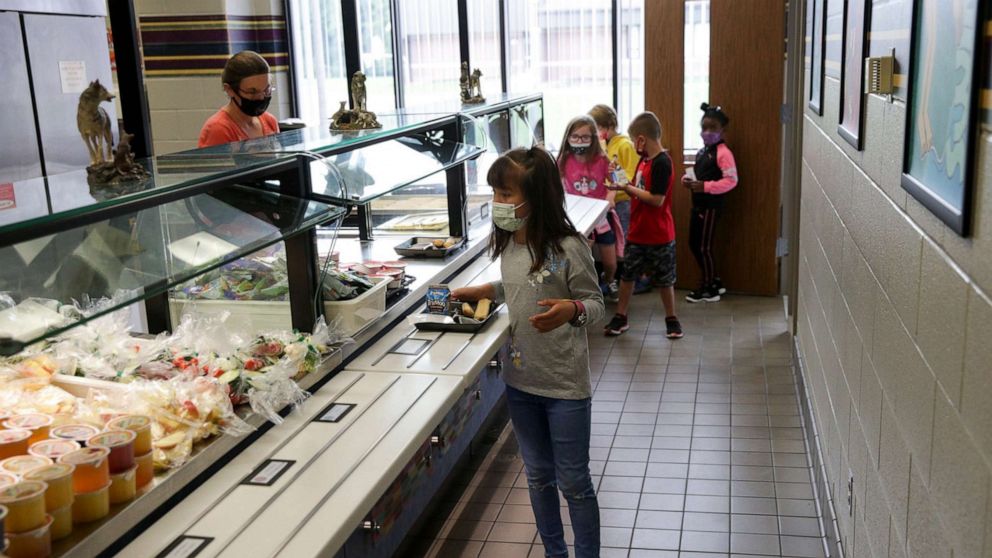School cafeterias, already on the brink of collapse, brace for end of COVID-era free meals
For some kids, it was the chocolate chip cookies. For others, the sloppy Joes. For Thresa Thomas, daydreams of lunch centered around coffee cake.
Thomas says she would hustle as soon as the bell rang. Since her Los Angeles school's lunch was first-come, first-serve, time was of the essence to ensure she'd get the fluffiest slice with the biggest hunk of brown sugar streusel. If Thomas was lucky, she says she'd get the lunch lady who'd let her pick out that slice, even if it was buried way in the back.

That's when Thomas realized her calling. "I wanted to be the lunch lady who makes [kids'] day," she told ABC News. For 14 years, Thomas has been living that dream at her old stomping grounds -- even on days when the Culver City, California, morning blurs in a frantic effort to get her famous orange chicken ready before the kids stampede into the cafeteria.
But amid the COVID-19 pandemic, that blur turned into a two-year delirium due to school staffing shortages and issue with securing supplies.
With colleagues missing left and right -- and amid a constant scramble to cobble together menus from whatever ingredients the kitchen had on hand -- Thomas called the past two years, "chaos."
"I try not to let the stress get me and I try to take each day one at a time," Thomas said. "Sometimes it's really hard, but we can do it -- we have to do it, I should say."
Thomas' struggles at the front line reflect the immense challenges school districts across the country have faced in the past two years to continue serving billions of meals to millions of children.
The challenges have been constant, school district officials say. Some cafeterias have been unable to fill kids' trays with basics like milk, meat and multigrain products as supply chains face crippling shortages. They've been chronically understaffed, unable to compete with industry for food service workers. And now, they're struggling to keep up with skyrocketing food prices.
The one source of respite? Pandemic-era Agriculture Department waivers that raised reimbursement rates and loosened restrictive requirements for school cafeterias, often the biggest restaurants in town.
But after Congress didn't extend the waivers in its spending bill earlier this month, district officials are increasingly worried about their ability to feed America's youth.
To understand the pandemic's impact on school cafeterias, look no further than what Danielle Bock, nutrition services director at Greeley Schools in Colorado, calls, "the great UBR catastrophe of 2020."
The UBR -- or, Ultimate Breakfast Round -- is a food product that is ubiquitous in school cafeterias and offers USDA-approved nutritional value, as well as staff-approved convenient pre-packaging, Bock told ABC News.
But after a February 2021 ice storm wiped-out a Rich's factory in Texas, the UBR disappeared. For months, Bock said, they couldn't get the product -- forcing a frenzied, and more expensive, pivot that left red ink all over menus that had been planned months prior. Over a year later, they can't get even remotely the same quantities they used to, Bock said.
Yet, the UBR was just "the canary in the coal mine," Bock said.
Over the past two years, school districts from Washington to Florida have faced worsening shortages of everything from dinner rolls to drumsticks. Trucks have shown up empty or not at all; manufacturers have stopped producing less profitable school-designed product lines; distributors have canceled contracts altogether. In Wyoming, school officials were sent hundreds of miles eastward to Sam's Clubs in pursuit of serving cups and dish soap. In Kentucky, officials started delivering milk themselves.
According to the USDA, 92% of school districts' cupboards ran empty at some point during the pandemic.
Meanwhile, cafeterias -- like other hospitality industries -- have seen an exodus amid the so-called "great resignation," Beth Wallace told ABC News.
According to the USDA, 73% of districts faced staffing shortages during the pandemic.
Wallace, who is president of the School Nutrition Association and executive director of Jefferson County Public Schools in Denver, said practically every third job in the district of 78,000 students is empty. The obstacles have been expensive: they've tried everything from wage hikes to signing bonuses to referral stipends, Wallace said.
Instead, Wallace said, workers keep choosing industry jobs at places like Target or Amazon that pay better with more consistent hours. Burnout is endemic in those forced to pick up the slack, said Thomas in Culver City.
Then, there's inflation.
Just as consumers have faced sticker shock in the grocery store aisles, so too have school been slapped with stunning price increases, over a dozen nutrition officials told ABC News

The price of tomato paste is up 30% in Michigan. Plastic fork prices have risen 50% in Colorado. Pineapple are up 120% in price for Maine's schools.
Jeanne Reilly, nutrition director at Windham Raymond in Maine, told ABC News that when pineapple cups jump from $0.20 to $0.44 a serving for thousands of kids, the numbers add up quick.
Higher reimbursement rates, thanks to waivers, have provided a crucial buffer amid these cost increases -- [they've] "helped us stay in the black," said Reilly.
But reimbursement will plummet up to 40% if the waivers expire, Reilly said, even as districts are being squeezed from all sides. Meals missing mandatory items like milk won't be reimbursed at all.
For Greeley, in Colorado, that's tens of thousands of dollars a day off the bottom line -- something the district, which already operates on razor-thin margins, will be hard-pressed to endure. (Nearly 30% of districts already do not break even, according to the USDA.)
The implications are more than dollars and cents.
Districts already "operate[d] on pennies" before the pandemic, Wallace said. But since school nutrition services are required by the USDA to be financially self-sufficient, they'll face a bleak set of choices: buy cheaper food; reduce labor; or cut certain meal services altogether. Wallace and others say they fear these could mean a step backwards for meal availability and nutritional quality after decades of hard-fought progress.
"Taking away flexibility from our schools now ... would send school and summer meal programs into absolute disarray," Michigan Sen. Debbie Stabenow, chairwoman of the Senate Committee on Agriculture, Nutrition, and Forestry, told ABC News.
Ten million kids will lose meals over the school year if the waivers expire, USDA told ABC News. That could total over a billion meals lost, according to data from the School Nutrition Association. Should school meal programs prune or shutter operations, the numbers will soar higher still.
That would be "a grim and catastrophic turn of events for families still trying to recover from the pandemic," Reilly said.
"And it will be the children of this country who suffer from it," she added.
ABC News' Anne Flaherty contributed to this report.




